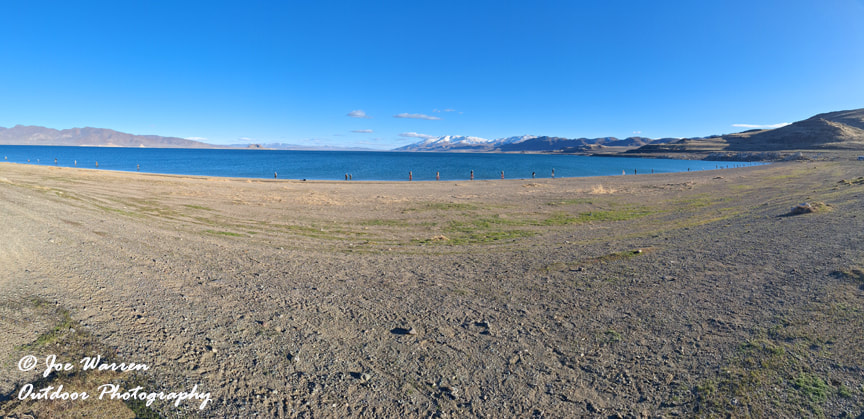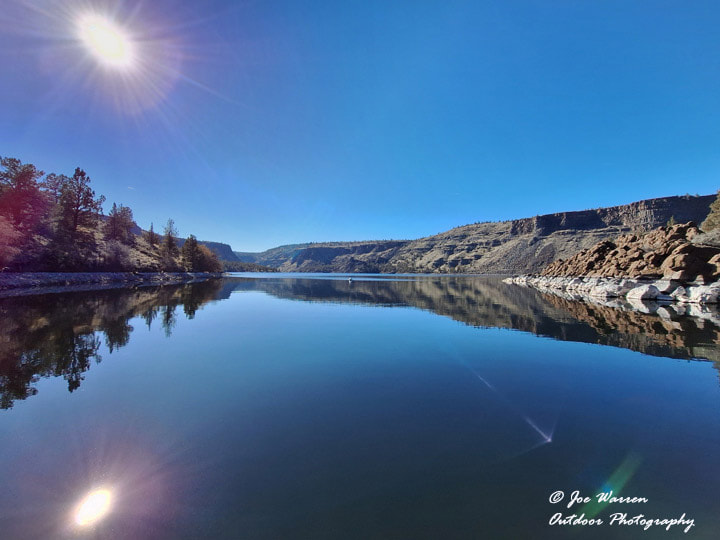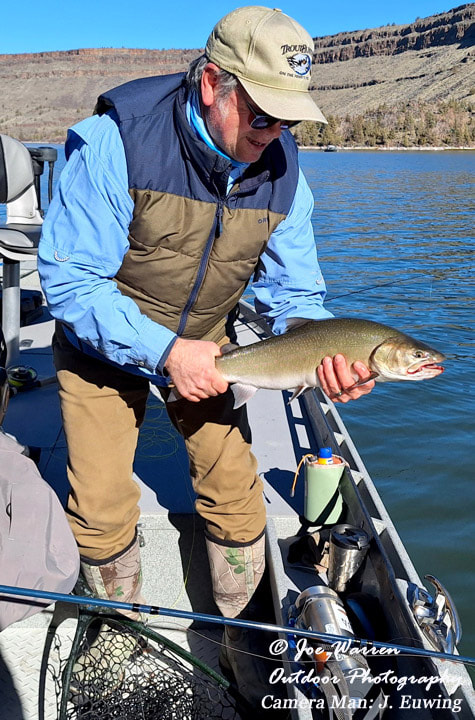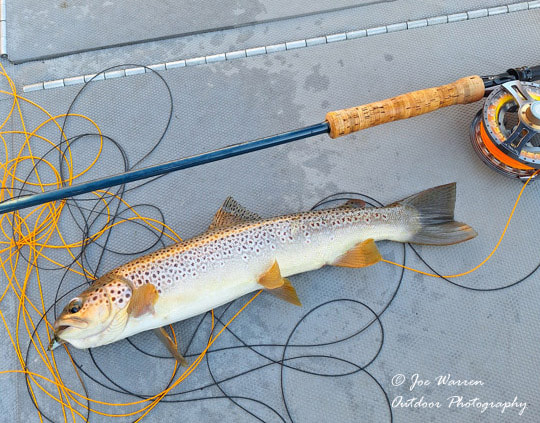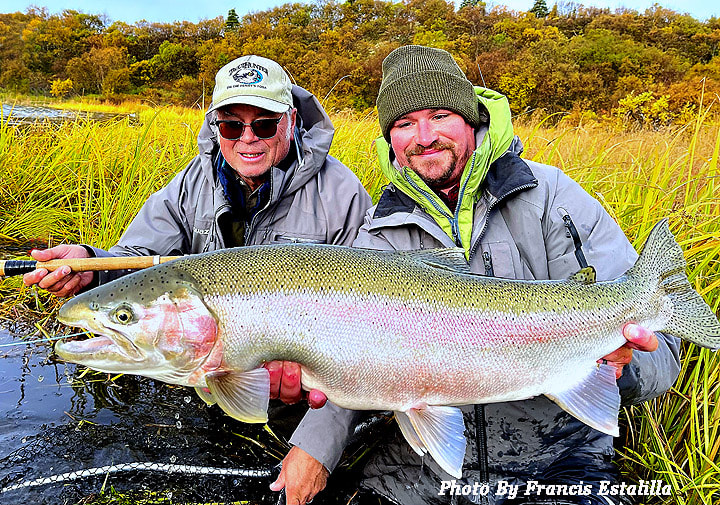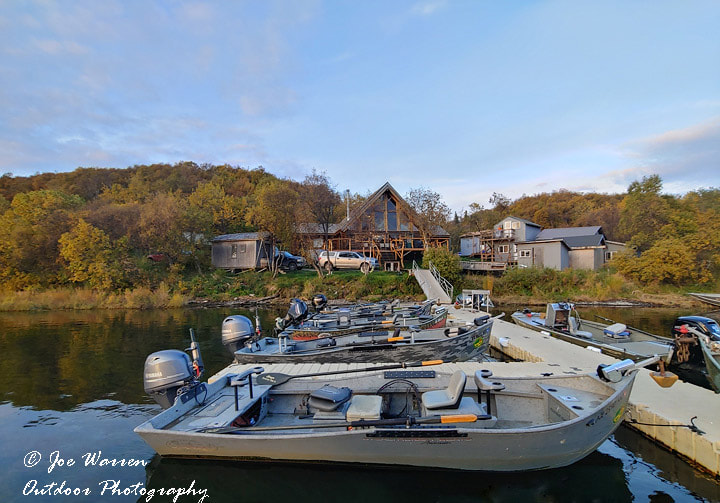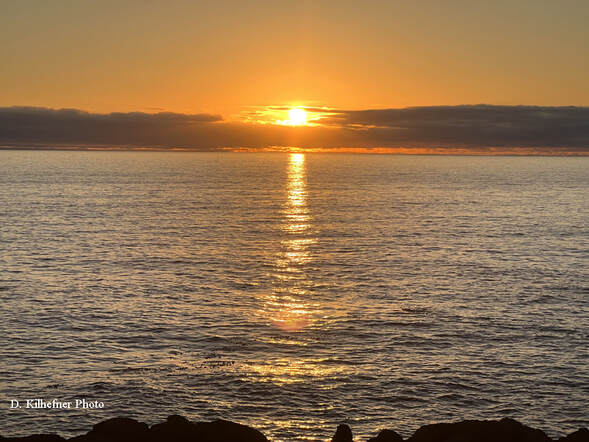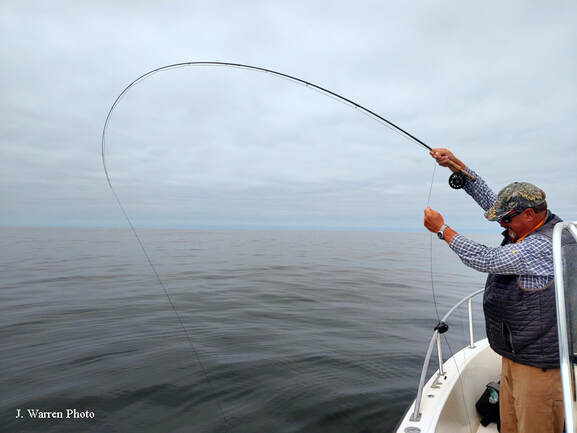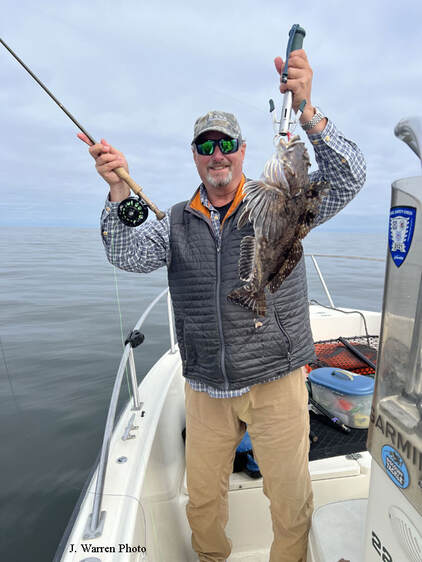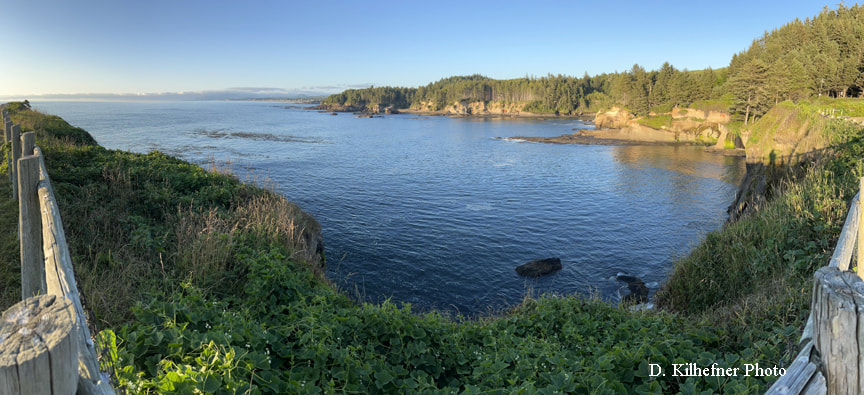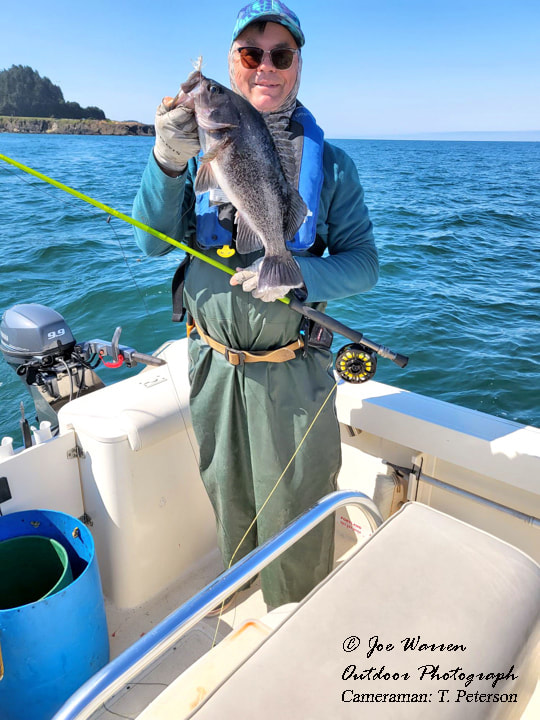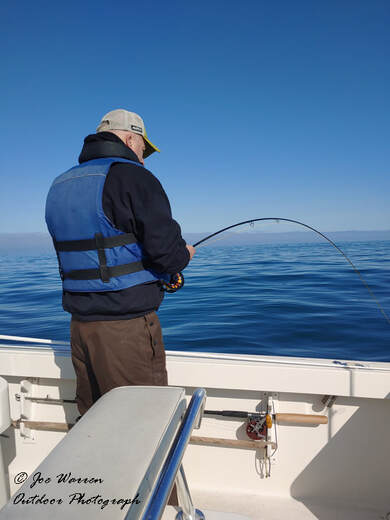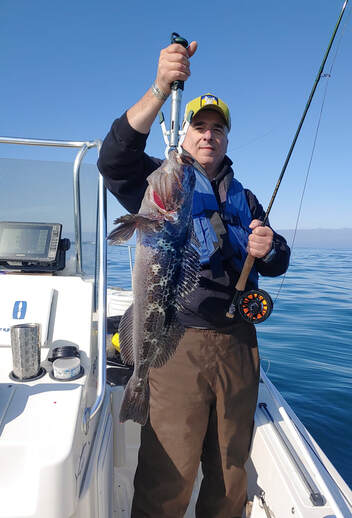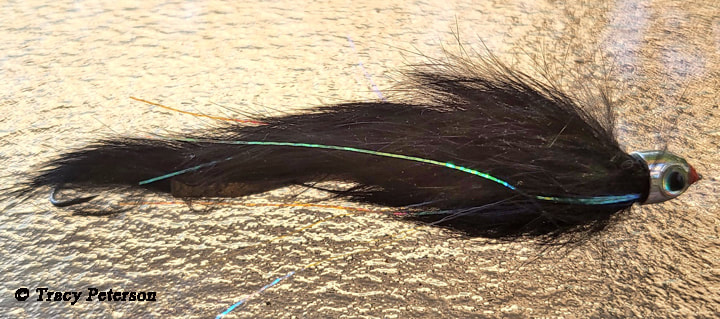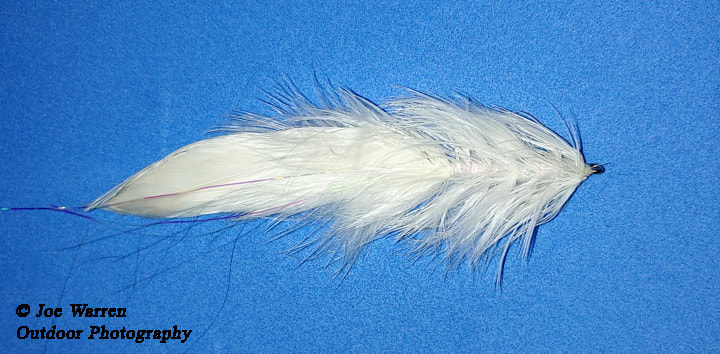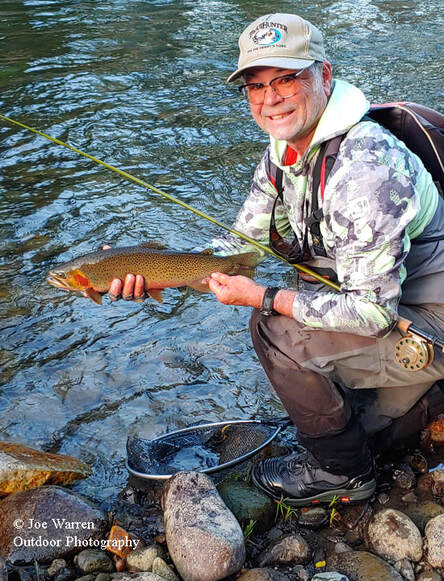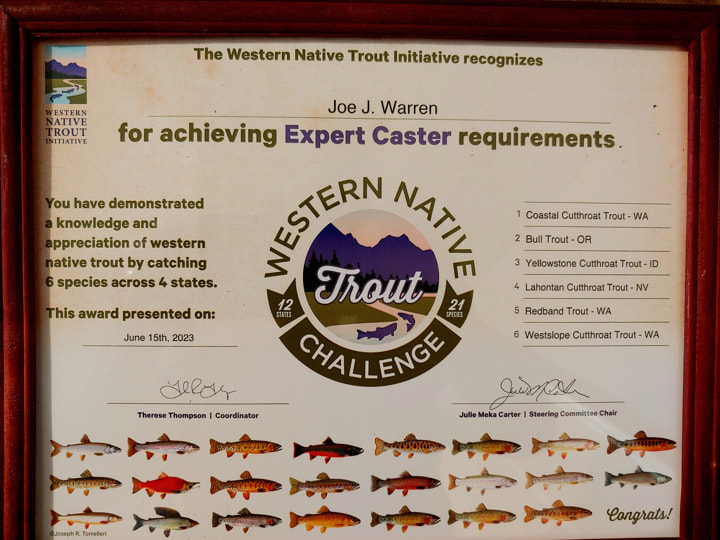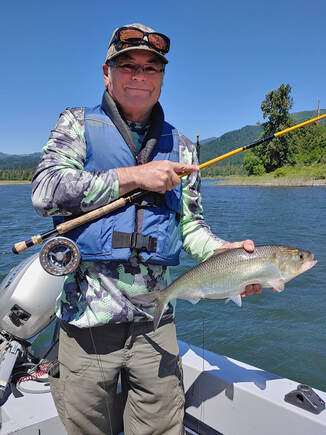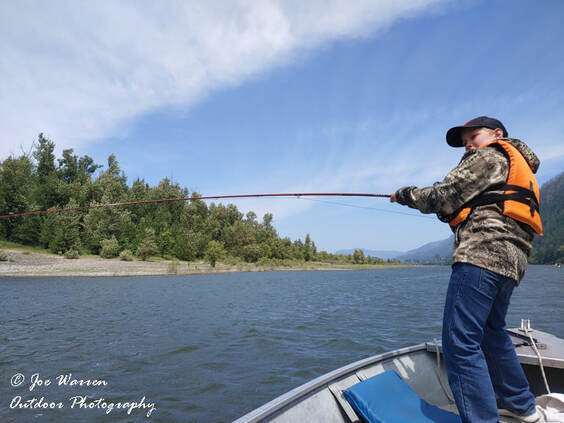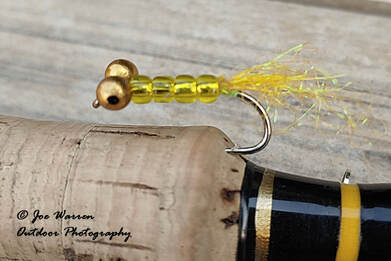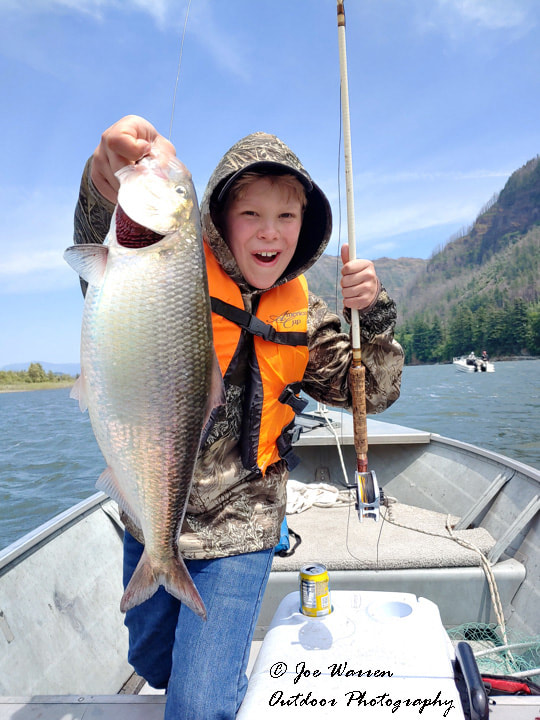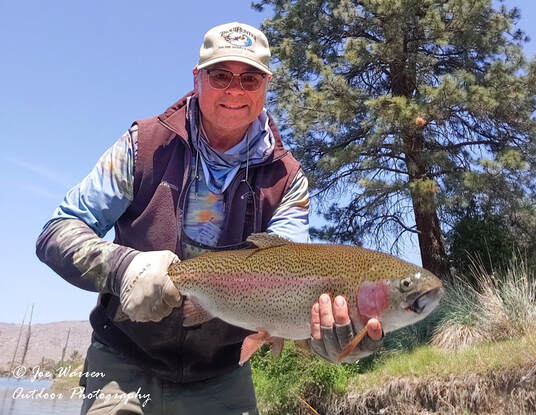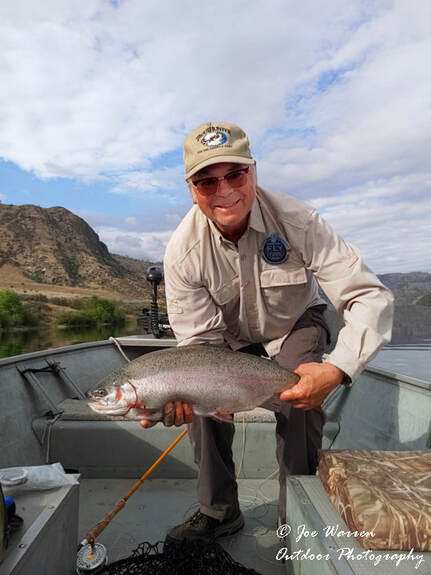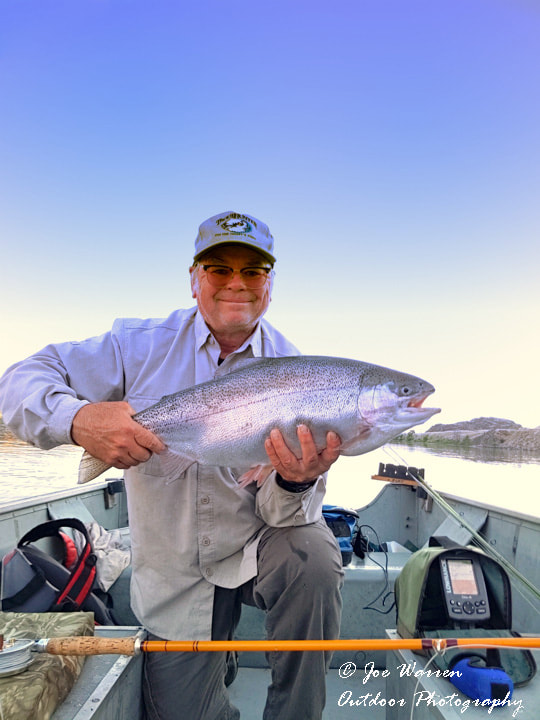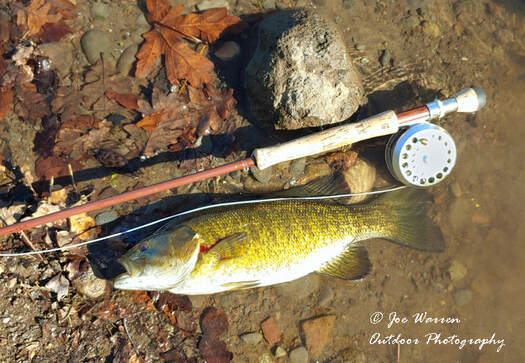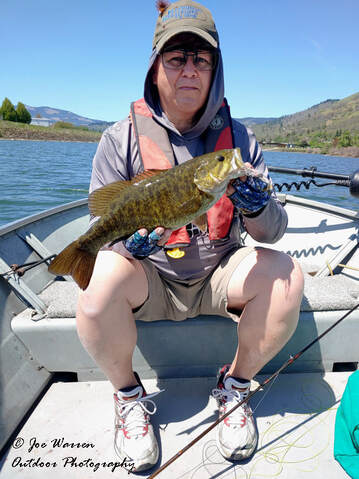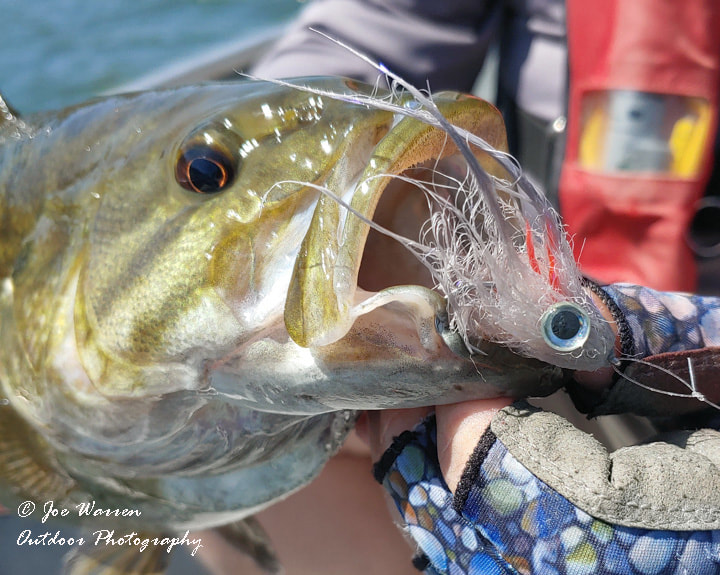A course of over 1,000 miles in nine days from buck brush country to the California giant redwoods to try and catch unique species of native trout in Southern Oregon and Northern California. A collective, catch and release quest to add specimens for the California Heritage Trout Challenge and the Western Native Trout Challenge. Day 1--In my faithful '99 Dodge RAM diesel truck with a camper on top, I departed Carson, WA for my adventure into sage brush desert in southeastern Oregon. Near the remote ranching town of Silver Lake, I would hopefully find my first specimen, the Fort Rock redband trout. According to agency records and internet anecdotes which was most of my intel in finding these wild trout in the boondocks. There are only several small creeks inhabiting this native trout. Before starting this quest, I didn't realize that redband trout populations are in fact geographically isolated making them likely to be genetically distinct. Thus, all redband trout are not the same. To start off, though, the trout are small, rarely exceeding 10 inches, but the places where these tough trout reside are nothing short of spectacular! And most of all, no other anglers were ever seen, except at one lake. At my arrival, I had about two hours of daylight left to fish. I picked a small creek from the map and found a suitable place to park and access the water. In these parts, there are many private ranches and sometimes that can put a hindrance on access. Be careful, not all land is posted and a fence doesn't necessarily mean is private either. The stream meandered through a small gulch with aspen and juniper along the way and thick maple vine-like brush on the banks. This made casting a challenge. When I casted my #14 yellow humpy into the first pool, I expect an immediate response. More casts followed but with no takers, hhmmm. Wow, I was already disappointed thinking it would be slam dunk in such a rural place. Moving along, I find another nice run with a some down timber. First cast, WHACK! The anxious trout missed the fly (and hook, thankfully). A second cast delivered another strike! This time I connected but much to my surprise, it was a 8" brook trout. I love brook trout in the right place and time but this was not one of them; it was not released. I moved along to another slow pool, with classic grassy bank, scattered shrubs and a steep bank on the other side. Suddenly, a trout slapped the surface and gave itself away. The next cast did the trick and I was thrilled to land my first Fort Rock redband Trout! Day 2--I spent the night in downtown Silver Lake, OR, to fish another creek for the Fort Rock redband the next morning. The trout seemed to be gathered in certain places, not necessarily where you'd expect them to be. I found one good spot below a short waterfall from a jammed woodpile and caught four trout. As I fished downstream very few trout showed themselves. By this time mosquitos were eating me alive and it was time to bail! The itch to keep going was pushing on me as I pulled back out along the desert highway 31 in the Great Basin Drainage. In numerous trips to Pyramid Lake, NV, I have passed the Cheuwacan River with a vow to return and try my luck. Today was that moment and with a swift right hand turn in Paisley, I headed for trout water! Unfortunately, the Chewy was high. I drove about 12 miles upstream and found a small tributary through a large meadow. I fished hard with no payback! I then found a rough dirt road that took me to the main stem where I could access it, but it too, shut me out; no luck today. So, there would be no Chewaucan redband trout on this trip, but return, I must! I continued my quest with the next redband species in mind, the Goose Lake redband trout. These trout exist both in OR and CA are known to inhabit a number of creeks on the eastern flank of Goose Lake. From the map, I found a random creek just off hwy 395. Culverts always seem to hide a trout or two and I decided to give it a shot. With a small hopper, I gave it a short cast and instantly raised two trout but the hopper was a little too big to get a hook in. I downsized to a #12 Humpy, made a cast and was stunned! Amazingly, this redband would be the largest trout of my trip! Though the trout are not lunkers by any means, the solidarity of dry fly fishing in scenic places and seeing no one, is priceless! With about an hour left of daylight, it was time to press on to make camp at Lassen Creek campground in California and meet with my ol' college buddy, Erik, who would join me for the remainder of the trip. Lassen creek (Modoc co.) is home to Goose Lake redbands, another notch for a redband in California. Day 3--After another run back to Lakeview for missing items, I returned to camp to find my fishing buddy, Erik, chilling in the shade after his long haul from Woodland, CA. It was great to see each other, but we made fast tracks to gear up and hit the water! We both geared up with fiberglass rods on this trip. Erik with a Moonlit 3 wt and myself with a Cabela's CGR 2 wt. The stream was slightly off color but the trout were still willing to raise up on a dry. However, a small, gold beadhead type nymph about 18 inches under the dry was very effective. We both scored for our Goose Lake redband! Erik landed 8 trout while I was humbled with 4 trout along with a speckled dace, my first one on a fly! There were a few bugs coming off, most noticeable were the micro skawla stones. The trout devoured pretty much anything resembling an insect on the surface, non selectively, my kind of dry fly fishing! Day 4--We continued our camping at the Lassen Ck to embark on the next search for the Warner Lakes redband trout. From readings on the internet and speaking with a CDFG biologist, I was encouraged to take a look at a small portion of a stream that flowed from Oregon, into California and then back to Oregon. It was called Dismal Creek. One can only hope that the name would not reflect the experience of fishing it. BUT IT DID! Aaaaahhh! We ventured in Erik's Toyota Tacoma 4x4 up the west side of the Warner Mtns only to be blocked by a big, snow berm! Okay, so I check the map for another route to approach via the east side, surely, the snow was all melted over there. We had to back track and then head due east to drop over the Warner Mtns on Fandango Pass into Surprise Valley where the ghost town of Fort Bidwell sits, about another hour's drive. Once again, we pursued the climb to higher elevation, go around the corner and BAM! Another snow berm. It was "dismal" alright. Without taking a huge detour into Oregon and arriving from the north, there was no other way to go. Erik was a trooper and remained calm in my navigation attempts, but he also was thrilled to use four wheel drive for the first time, in his new truck. Now he is a real boonie bouncer! Supposedly, small populations of the Warner Lakes redbands exist in the small creeks on the east side of the Warners. It was a matter of time to find one. On the way down the hill, we fished Bidwell Ck, and each caught a small chunky brown trout, which is fine with me, but not while pursuing native trout species. With that, we move on to plan C. The pavement ended resuming on a dirt road as we headed north to another creek, Twelve Mile creek. We arrived right on the CA-OR border in the middle of nowhere! Unfortunately, private ranches surround the creek and we could not locate owners to seek permission to fish the creek. A very short section at the bridge was accessible but there was no reaction to our flies. Time to back track again, plan D. Back to the map, I noticed a very small creek with no name draining from the highlands from upper creeks and since it was not far off the beaten path where we came from, we went to check it out. I know from experience during my boyhood trout fishing that trout do not need a lot of water to survive, so small creeks or rather "tiny" creeks are not out of the question! On the first micro pool I cast to, a fish immediately crashed on my #14 caddis! What appeared to be a redband trout, was now in the net! Hallelujah! However, this trout still needs a proper approval for authentication by a CDFG fish bio, but it sure looks like a Warner Lakes redband trout to me! I had a great time on this tiny creek having landed 8 trout! Unfortunately, Erik did not fare so well and was not able to get on the board. Compelled to see my friend score on a Warner Lakes redband, I had to find one more creek. Back to Surprise Valley Rd, we hightailed it towards Cedarville in hopes of one more trout bearing creek. We found a creek and checked it out. It was kind of a steep gradient creek with small plunge pools, which at first did not yield any trout. We pressed on climbing higher in elevation and then found the perfect spot right next to the road. Erik bailed out of the truck with his trusty glass fly rod and I had the landing net. It all came together, the perfect piece of stream, plenty of room to make that 10 ft cast and bingo! A fatty of a redband came to the net! Now Erik was on the board! It was a long day but well worth it! We saw and fished some incredible country in the far northeast corner of California and had it all to ourselves. Finding Warner Lakes redbands was a major hunt, but that is part of the fun. Sometimes you win, sometimes you lose. But today we were winners! Day 5--We broke camp early, hopped on 395 and headed south to our next trout destination for the Eagle Lake rainbow. This trout is also listed on the California Heritage Trout Challenge as well as the Western Native Trout Challenge. We set camp at the south end of the lake in Eagle campground. One of my sources told me fishing was not so good and to fish the south end. Erik and I talked to a number of anglers (no fly anglers) after our arrival only to hear the same story, no fish! The situation was not looking good. Having watched a video of a fly angler who fished another lake that was supposedly stocked with the Eagle Lake rainbow trout, we decided to make the hour long drive to that lake, Crater Lake. In short, it was a beautiful lake, turquoise clear, you could actually see the trout swimming under you! Best of all, the trout were busting ant patterns on top! Good numbers but not so good in size, 12 inches tops. I later found out from a CDFG fish bio that different stocks of rainbow are stocked in that lake making it difficult to discern the ID. Furthermore, these trout do not count towards the CA Heritage Trout Challenge, but amazingly do count towards the Western Native Trout Challenge. However, I would not consider entering a trout from this lake for the WNTC simply because it doesn't qualify for the CHTC. As you view the slide show below, you can see the variations of these rainbows caught from Crate Lake, CA, and they definitely have variable markings! Whether or not our catch would be an authentic Eagle Lake rainbow was not terribly disappointing given the fact it was a beautiful lake, few people/anglers and the action was pretty much non stop. With still plenty of day left by the time we arrived back to camp, I just had to wet a line in Eagle Lake. I waited for the last the two hours of daylight hoping for some surface activity. The lake was virtually vacant of any boaters or anglers. From my Water Master, I worked the rocky shoreline with a sinking line and a burnt orange bugger with no takers. Then I switched to an olive scud trailed by a chironomid. In just a few casts, the line came taught and after raising the rod, there was bucking action on the other end! YeeHa! It felt like a good fish and I couldn't wait to see my first Eagle Lake rainbow . . . No Eagle Lake rainbows were caught in the large alkaline lake this time but hopefully in the near future! Not feeling confident about the fishing, we decided to head out in the morning to the next trout haven. Day 6--On the road again following hwy 89 to the northwest towards Mt Shasta with our next stop on the upper McCloud River for the McCloud redband trout. Once more, the scenery was incredible. We set camp at another forest service campground called, Cattle Camp campground, conveniently located close to the river. It is interesting to note that most of the information on finding redband trout pointed to tributaries to the McCloud, so that's where we started our hunt. However, things were not what we expected! Talk about disappointed! Not far from this dried up creek was supposedly another stream, Ash Ck. It did have water, but it was literally a trickle that was obvious run off from Mt. Shasta. Check those two off the list! We continued driving from creek to creek but one thing kept repeating itself, major bush wacking! The riparian vegetation was like major vine maple, so dense, you could barely see the water let alone step foot in it! Access was tough. I don't know why I didn't think of it sooner, but we finally ended up on the McCloud River. It had its fair share of heavy vegetation but at least there were more open places to cast! It is a beautiful trout stream to say the least. There's a nice trail following the stream for quite a distance making it very convenient to bail off and fish open water when suitable. The first few catches were brook trout (not released) and I began to wonder if any redbands existed. Erik also landed a small brown trout too. Eventually, we caught our first McClound redband rainbows and let's just say some places were better than others even though we fished habitat that looked very fishy. This stream is loaded with a diversity of aquatic insects with the likes of caddis, stoneflies, and mayflies. I think the trout are in good shape! Day 7--A great day to relax and catch more trout from the McCloud. The stream is nothing short of spectacular in its scenery, plus perfect weather, and again we had the stream to ourselves. An amazing sight was the stream teaming with numerous species of butterflies! I've always been kind of a entomological nerd, but butterflies are high on the list. As if having a tea party, there was a large gathering of butterflies sucking up minerals from the moisture in the stream side gravel beach. I couldn't help wondering how the area is such an attraction for these colorful insects. The McCloud River presents itself as wild and scenic along with aggressive trout rising to the dry fly. I can't wait to return . . . Day 8--Up in the morning with the rising sun to hit the road again. The next and final stop is the Smith River in the California redwoods for the coastal cutthroat trout! A good four hour drive to arrive there going north to Grants Pass, OR, then jagging south back into CA. If you don't have camping reservations for a state or federal campground on the west coast, you're out of luck. However, in the small town of Hiouchi, we found a comfortable base camp at Redwood Meadow RV Park. Still mid morning, we anxiously loaded our gear into Erik's road worrier and went trout hunting. We started on small tributaries in the lower main stem Smith River. It's not uncommon to find cutties in the smaller tribs and if you're limited on time, this can be profitable. Mill creek is well known as a cutthroat stream, but you earn your catch on this drainage! It has limited access due to heavy vegetation and steep drop offs. Even when you do reach the stream and try wading the shorelines, it eventually turns into deep pools with rock walls on both sides making it impossible to wade further (unless you swim)! Lots of hiking to find angling places on this creek! We caught a few rainbows (likely juvenile steelhead). We fished the main stem of the Smith later in the evening and I caught my first coastal cutt from there, in an ideal riffle with excellent seams and glides where trout wait for their prey. Dry fly and dropper did the job just fine! The giant redwoods are breath taking and unbelievable. Erik on the left, me on the right. Day 9--The evening before, we met our neighbor, a young high school teacher who was a born and raised in the area and he was fisherman! He gave us great information for better access to Mill Creek and to check out the So. Fork of the Smith. But it was one clue that really fired me up; the cutthroats love crayfish in the Smith River! I love streamer fishing and it just so happened that I brought my crayfish fly box! We headed back to Mill Ck to one of many hiking trails our new friend told us. The hike itself was amazing, again with redwood trees towering over us. Once on the water, the fly rods went to work. My effort yielded zilch, which was hugely disappointing after going through classic pools and runs. However, Erik, clicked right in with catching trout and scored on his coastal cutthroat! I still wanted a shot on the river fishing a crayfish fly so we packed up and headed for the So. Fork Smith R. Once again the access was few and far between until we came upon a trail access to the river. The water caught my attention immediately. I would have never expected such clean, crystal clear water and clean, smooth rocks. It looked like the streams I'd seen on videos in New Zealand! Wow! You just wanted to crouch down a take a big drink, it looked so good. Since I would be upping the presentation a bit, I broke out the McFarland 8'8", 5 wt, a custom glass rod that is a dream to cast and fish. I used a type III, 20' sink tip with a short leader to a crayfish fly with dumbbell eyes. It started out kind of slow, but to be expected for the first time in a new area. On the third hole, I made a quarter cast, let her swing to the end of the outlet and then striped the fly back in the slower holding water. Half way through, KAPOW! Super aggressive take from a feisty and decent size cutty pulling with all its might. The fish was a nice, 13 incher and the largest cutthroat for the last stop. It was an epic moment to close the final chapter. This was a special and amazing DIY fly fishing trip. To venture from mule deer country to giant redwoods is one of the most incredible journeys a fly fisher could make. I caught five species of redband trout and the CA coastal cutthroat. The virtues were many, but most of all not encountering any other anglers or people for that matter on the creeks and streams we fished. I know some anglers could care less about catching 6" trout but it's what they are and where they live that make it worth while! The travel and camping was great, me with a motel on wheels and Erik with the shuttle truck to easily take us to out of the way places. A great combination to have! I think the most challenging trout was the California coastal cutthroat trout followed by the Warner Lakes redband trout. We caught a total of 4 cutthroats, the least number of species for each given group of trout. With the Warner Lakes redband, it was persistence that paid off. You have to be willing to go into the unknown. The other challenge was the bush wacking! Many of these trout streams are covered by thick vegetation. Trying to get a cast in or a short line dab proved to be difficult at times. Again, you just keep poking and prodding until you hit the sweet spot and an amazing wild trout comes to your net. Ya, with all that hard work, who wouldn't get thrilled in catching a wild 6" trout!
Best wishes to your fly fish pursuit! Joe
0 Comments
March 11-16, 2024 To be perfectly blunt, it was a very tough 6 days of fly fishing. The trip was, as they say, "great fishing but lousy catching!". I traveled to Nevada with 4 other anglers and the company was great, which definitely helps take the edge off during a lack of catching! We also joined up with long time Pyramid Lake fly angler and retired guide, Doug Oullette. The first day was spent at Sand Hole that resulted in 2 fish caught out of our party of six. The next five days we went south and hit the marina (zilch), Windless (1 fish), and Pelican Beach (10 fish). Even the North Nets were dead according to reports. Needless to say, we spent the most time casting from Pelican. The better bite, if I can call it that, was in the evening. We made no rush in the mornings as we later learned hardly anyone was hooking up. We don't bobber fish so everyone was stripping flies. Majority of the catches came on the o'l, reliable, Popcorn Beetle. Secondly, we didn't bring any of the jumbo cutts to the net. So in 6 days, I caught 4 trout, which tied for the worst trip I've ever had to Pyramid, but that's way fishing is. A colder than usual water temperature might of had some effect and supposedly, and a decrease in trout plants are suspect as well. From my landings, my best fish were two, 9-pounders and a 6- pounder. All from two days out of six, ouch! After we returned home, my buddy texted an instagram of a spin fisherman who, five days earlier landed a 25-lber from Pelican Beach. That's Pyramid for ya, some days you can't do anything wrong and some days you grind and grind and maybe hook up once. But if that one time comes from a 20+ pound leviathan, then the long miles to drive there is a huge success! Obviously, this is the Pyramid Lake dream we want to experience! Best wishes to your fly fish pursuit! Joe February 13, 2023
It didn't even seem a like a winter day on Lake Billy Chinook once the sun popped over the canyon rim. To have a bluebird day can be rare on LBC let alone in winter, but, it didn't do much for the bull trout that's for sure! Fishing with long time angling friend, Jerry Ewing, we started fishing on the Deschutes arm. It was the first trip out for both of us and we were eager with anticipation. Casting the usual 3 to 4 1/2 inch streamers, we made one cast after another with very little to show for. By the time 10 o'clock rolls around and you haven't brought a fish to the boat, you begin to wonder. Not a whole lot going on. Like saying goes, great fishing, no so good catching . . . . In the afternoon, we switched up location and ventured over to the Crooked arm. My luck finally changed with a very stout, 24 incher! Ah ha! I thought this would be the start of something big for both us. Unfortunately, things remained cold and our arms were becoming fatigued. By late afternoon, we each picked up a mid-size brown and Jerry an additional rainbow. Not the kind of bull trout action we had hoped for on such a nice day, but it was great to get out and blow the cob webs off. Opening day of the Metolius arm opens up this Friday and it will be interesting to see what happens. The water temperature is still in the low 40's and might delay a good bite. But, one big bull makes a great day! As the water warms up so should the bite. I'll look forward to getting back out and hopefully wrestle a 30 inch bull as the beginning of 2024 continues.
Best wishes to your fly fish pursuits in 2024! Joe Sept 24-29, 2023 This report comes a little late as time slipped away due to higher priorities. None the less, 2023 went out with a big "bang" on an epic fly fishing trip on the Naknek River, Alaska, which closed my fly fishing season for the year. But WOW, was it stellar! I joined up with George Krumm, editor of Fish Alaska and Hunt Alaska magazines, on his annual group trip to Katmai Trophy Lodge on the Naknek during the last week of September. To be quite frank, the rainbows in the Naknek have to rank in at least the top two if not all time best rainbow trout fisheries in the world. I mean, just look again at that top photo! These are "resident" rainbows hailing from the enormous Naknek Lake, upstream. I have caught steelhead like these large resident rainbows but never inland rainbows of this magnitude! But the most important fact remains about these trout; they are 100% native and wild! Some do reach over 20 pounds! My stay was booked at the Katmai Trophy Lodge (KTL) located on the Naknek River. The package included 6 days of guided angling. One of the nice options at KTL is that they offer other fly fishing excursions at no extra cost (as of last year). You can choose to fly fish the lake for Artic char, a trip I did the first day to catch my first char, or a trip to the Brooks River for more rainbow fishing and/or bear viewing. Google Katmai Trophy Lodge for more details. The focus of the trip is for the rainbows. But as mentioned above, I did take advantage of pursuing Arctic char since I had not ever caught one. It's a long boat ride but the char are a nice size fish ranging from 24 to over 30 inches. Since it was the tail end of the coho run, the char stayed close to lake tributaries offering spawning salmon, to feast on eggs and perhaps salmon flesh. A 7 or 8 weight rod is good for this fly fishing using a floating line. Bring a short, quick-sinking tip for back up. Stout tippet is best, at least 12 lb, as you will likely foul hook salmon and you need to get your fly back! Streamers such the famous egg-sucking leech or rabbit strip leech patterns worked very well. Have some with cone or dumbbell eyes too. A productive color is purple, by itself, or mixed with colors, pink, fusia, fl orange, etc. If you have an egg sucker, the egg can be fl pink or fl orange. I also caught a few coho while char fishing, but they colored up and pretty tired. In the river, there are quite a few grayling, so if the rainbow fishing is slow, ask the guide to put you on a grayling hole and pull out the 5 wt. The standard indicator with nymphs works great or if they're on a hatch, dry fly fishing is good too. I noticed size 12 caddis coming off the river. O good 'ol olive, elk wing caddis will likely do the trick. Wait for slide show or click on image to pause or move The rainbows are the star of the river and for good reasons. The river itself is a pretty good size, much larger than any of the western rivers I'm used to except for the Columbia. There are multiple tactics to use while fly fishing for the trout, however, using the long, spey or switch rod is the way to go in my opinion. I was pretty rusty on my spey casting not to mention having to cast from a boat. I did practice before the trip, but thanks to George and the guides, I was able to make decent casts. You don't have to be the most accomplished spey caster and you don't have to cast a mile to reach the fish! In fact a well placed 30-40 ft cast will do the trick! The most crazy tactic I have ever experience was when to set the hook! Just the opposite, you don't actually set the hook, you let the fish hook itself. Naturally, I botched the first strike as I over reacted with the classic "trout-set" and was promptly reminded of my mistake. Soooo, as the fly swings through the current and a fish takes, you freeze! Then you watch your fly line depart from the reel as it rotates about 3-4 or more revolutions. Finally, you simply raise the rod to an angle towards the bank you are fishing next to! I have never experienced this type of hook-setting and it can drive you crazy. But the technique is very effective and the hook generally sticks in the corner pocket (i.e. corner of the mouth) as my buddy, George says, and it's game on! These rainbows are turbo charged, so when hooked, you're in for a big fight! Seeing the backing come off the reel is common as they take advantage of the big river's current. Some times they are even acrobatic. I had a 29" hen jump 6 times, and was clearing the river 2-3 feet on every jump! Wait for slide show or click on image to pause or move For the rainbow fly fishing, I used Echo, 6 and 7 weight, 11 1/2' fiberglass switch rods (my buddy George fished graphite 7 & 8 wt switch rods in about the same length). I used skagit heads on these and carried a wide range of 10 ft. tips from T8 to T18. I used a floating skagit head on the 6 weight for shallow or slow water and an intermediate sinking head on the 7 wt. I carried various size split shot to add on for those "just in case" moments for deep or faster water. About six feet of 15 lb tippet on the end is all you need. Do not go lighter or you will sob when a +30" bow parts your fly from the leader. On the flies, a #2 hook is recommended, note the tail lengths past the hook in the above image. These trout will short strike. On the tandem fly patterns, only the rear hook is necessary. I was told that these rainbow prey on small lamprey. The bunny tail type flies in black worked well for me as did the tandem flesh fly or more commonly known, Lady Flesh fly. Olive, brown and copper color versions are very good too. As for the catching, it can be a bit like steelhead fly fishing. You might catch 2 in one day, zero the next or have a big haul with 6-10 fish. Your chances of hooking a big rainbow are very good. I'd say the average rainbow ranges from 22-26 inches, but the ultimate catch is the 30 inch mark. I never go to a place with big expectations, but I was fortunate enough to land some very large rainbows, the biggest ever in my life, as a first timer to this famous fishery. It speaks volumes. For weather, we had fairly decent days, some were sunny, some overcast and some drizzle. We were fortunate not to be in big winds, which are common as the season progresses into September and October. I think our group did very good and this was George's first time to try end of September as he usually fishes in October. There is excellent fishing in October if you can brave the weather. Special thanks to Francis "Doc" Estalilla for his video production As you run up and down the river in your guide boat, you notice some anglers wade fishing. We did very little wading and our best fly fishing was swinging flies from the boat. It took some getting use to (two guys casting switch rods from a boat), but for a river of this size, it sure makes for easier fishing. The guides know exactly where to place you for the best presentation possible. Their boats have both oars and a motor to maneuver the boat on a dime and put you on the fish!
No matter what level of trout fly fishing you like, this one needs to be on your bucket list! Even more so if you are a trophy trout hunter. Steelhead fly fishing in the west is straining to say the least. The Naknek sustains a very healthy population of rainbows that is not going anywhere (catch and release only). With all five species of salmon returning to the Naknek to spawn, it's no wonder how these trout grow so large. Even though this trip was my last for 2023, it was the beginning of a new relationship with the Naknek! Ya, I love it! Tight lines on your fly fish pursuits, Joe July 9, 2023 More Rockfish Fly Fishing! "Red sky at night, a sailor's delight"! Wow, the evening at Depoe Bay was gorgeous promising the next day to be just as calm! The marine forecast over a 6-day span was the calmest I've ever seen in my 23 years of fishing out of Depoe Bay! Seeing 3 days of flat ocean is pretty special but 6? That's a miracle! For fly fishing out of a boat on the Oregon coast, you couldn't ask for better conditions and even the fish cooperated as well. I hope days like these are not far off for the rest of the year. It didn't take very long at all as I found a nice shallow reef when fly fishing friend, Dave Kilhefner, hooked up. His fly rod more than doubled, and I knew right away it was not a black sea bass! Dave managed his rod perfectly without breaking it or the leader to keep the deep critter from going back into its rocky hole. Only two fish pull this hard and that is either a lingcod or a cabezon. After going back and forth on the reel, a good sized, cabezon (aka cabie) finally revealed itself. With those giant pectoral finds and broad tail, they possess incredible pulling power! Much to my surprise, Dave's cabie is the first one I've seen caught on a fly. But then again, lingcod eagerly take flies, so why not a cabie? These are delicious table fare, a bugger to fillet but are well worth it! The fly fishing was pretty consistent and the fish were spread all over the water column from 10 feet below the surface to the bottom. We fished in 30-45 feet of water. The sonar showed good numbers of suspended blacks which eagerly take a fly when you drift over them. Big schools of black rockfish typically means a fish every cast as long as they're under or around your boat. However, if you want a shot on catching a ling or cabie, you have to wait a bit longer for the fly to reach near the bottom before you start your retrieve. One technique to reduce casting is, once you strip your line in and you come to the fast sink tip portion (usually 30'), you can just start stacking your fly line back into the water and as you drift, the line will straighten out and likely be near the bottom. The ocean was like a like a lake! We used the same flies as last time, all white with flashabou; works very well. My friend, Dave, fly fished with a 9-ft., 6 wt fly rod using a 300 gr Airflo Depth finder and easily held his own on hooking up. But if you have a 7, 8, or even a 9 wt fly rod, I would go a little heavier. A short, 20 lb test leader, four feet long works great. It also allows you to handline the fish into the boat easily. But you should have a larger, salmon size net just in case you hook a big ling or cabezon! I actually experimented with a steel leader attaching a Mustad quick connect to change flies instantly. The leader worked great but eventually the end became kinked but that didn't stop the fish from grabbing the fly. I spend a lot of time researching the marine forecast. No one likes to fish in a rough ocean or waste a trip over only to find you can't get out and you certainly don't want to miss a good ocean. I like to use several websites and apps. www.weather.gov/portland gives you the NOAA forecast. Type in the location in the upper left hand corner. Then scroll down to the little map and click a spot offshore from the destination you chose. You should get a forecast on marine conditions but it only gives you about 4-5 days out. This forecast is typically on the aggressive side. Another one I really prefer is Windy.com. Get the Premium subscription. This will give you 10 days out on the marine and weather forecast. I also use tides4fishing.com and the app called NAUTIDE. These have many tools to use for ocean conditions and fishing.
As calm as it was this last week, I wouldn't have hesitated to take out a 14-foot boat. But also keep in mind that Depoe Bay is very popular with the kayakers, although I don't know how feasible it is to fly fish from one in the ocean. Just make sure you a have marine radio which is required for exiting and entering the harbor! Hope you give this fishery a shot, it's a blast! Best wishes on your fly fish pursuit! Joe Depoe Bay Fly Fishing The author with a very nice black rockfish, while fly fishing outside Depoe Bay, OR, from his boat. It's always a crap shoot on what the ocean is going to bring you in the way of weather. As I began to monitor the marine conditions, I finally see an open window and hope it will be close to accurate! I anxiously ring up Tracy Peterson from Hareline to tell him, "now is the time"! This is the first trip of the season to take the Josie Mae over to Depoe Bay and start the season, only this time with the fly rods! I've waited a long time for this and having fly fished many times in other locations on the coast, I would finally fly fish in my own boat! Nature has a way of telling you that you that a good day is before you. As we cleared the Depoe Bay rocky gateway, a young grey whale gently porpoised off the starboard side only a few boat lengths away. Very gracefully as if to say, "you're gonna have a great day boys!" First thing in order is dropping off the crab pots. With fresh shad for bait that was caught only a week prior (see shad fly fishing post), we scatter four pots at various depths. Now it's time to find the sea bass and whatever else lurks from the reefs! I've been fishing out of Depoe Bay since about 2000, rarely missing a season whether it was for rockfish, salmon, halibut or tuna fishing. Most of these trips were with my father, Jim. But one fateful day, he didn't come back from the ocean. In September of 2017 his boat capsized and he and his fishin buddy did not make it. I was fortunate to have fished with him only 3 days before the accident. I learned many tactics and techniques from my dad and have been blessed to continue catching! I didn't miss a lick on going back to Depoe after my father passed away. I bought my own boat the next year and kept fishing ever since. The first few years I continued taking out guys who regular fished with my dad and we recalled the good o'l days, fishin with Jim! It was also with my dad on his boat out of Charleston, OR, many years ago, that I caught my first black rockfish and lingcod while fly fishing. He and my uncle couldn't believe how fast I out fished them! Frankly, I was rather surprised myself. Fly fishing can be very deadly! There are basically two options for fly fishing the Oregon/Washington coast. From a jetty or from a boat. I've done my fair share fly fishing off of jetties and it's not for me. Kudos to those of you who are good at it, but quite frankly, I find it a hazard. The boat fly fishing is my game. The key to fly fishing from a boat off the Oregon coast is knowing the reefs and shoreline paying close attention to the depth. Fishing with gear first is a good way to learn locations. Next is picking a day or days when the marine conditions are calm enough to cast and fish with a fly rod. If the drift is too fast, forget it! Yes, you can strip out fly line without casting, and let the drift take it down to the fish as long as the sea bass are in a big area, otherwise you might lose out on drifting past them before the fly has a chance to reach them. I always take two rods, one with a 400-490 gr sink head connected to an int. sink line such as the Airflo Depth Finder and Sniper and the other rod with a floater or int. sink line just in case the fish are on top! Other comparable sinking fly lines are the Teeny T-series, Cortland Compact and the Orvis Depth Charge. I like to use an 8-wt fly rod, in glass of course, but rod weight really depends on how heavy your fly line is. My rod can easily cast 300-490 gr, so this gives me a lot of leeway on making sure I can reach the fish. Leaders should be stout! I highly recommend at least 20 lb. tippet, 4-6 ft long. I made the mistake of starting out with 15 lb and hooked into something very large, likely a ling or cabie, and before I could get the boat moving, it broke me off. Wire might not be bad idea either if you're in ling or cabezon territory. Another trick we used to make sure our flies sank quickly was adding a 1/8 oz tungest sliding bullet on the leader. No doubt this makes for some serious, "chuck n duck" casting. Bring a hard hat :) Also you can use the Popvic's Jiggy Head, a tungsten cone on the fly or again let it slide on the leader. Flies don't have to be fancy, good types are oversized buggers (use rabbit or schlappen for the tail), Clouser minnows, basic streamers that imitate an anchovy or sea lance, rabbit strung flies, like or close to a Dolly Lama, on size 1/0 to 4/0 hooks. White or pink flies seem to draw a lot of strikes and are usually my first pick for a pattern. A fair amount of flash on the fly is always good too! Be sure to throw in a few poppers (pink n white or blue n white) just in case the blacks are on top! Bunny hair patterns are great for the ocean like this Dolly Lama type fly tied by Tracy Peterson, which is what helped him catch his big lingcod! Joe's, Baja Bugger tied with large pearl glass beads, well proven from Baja to Oregon! Good electronics is your best friend when hunting for fish and saves time! The weather can change instantly, so the sooner you get on fish, the better! The primary candidate is the black rockfish or sea bass, which are found in many locations and depths. A suspended school is what you hope for. For example, if you're in 40 feet of water, hopefully the rock fish are in the first 15 feet of the water column. If you allow your fly to sink close to the bottom, you stand an excellent chance of hooking up to lings, cabezon, greenlings and other species of rock fish. Earlier I mentioned fishing next to rock shorelines, which, can attract many fish especially if there is kelp and sometimes never get touched by anglers. But beware of ocean conditions and make sure you have two motors! Keep a respectable distance, getting slammed against the rocks is a high risk! Last but not least, is the harvest! All of these fish are delicious and I love sea bass tacos! There are no size limits on the blacks but you can be selective, I would toss back any bass under 15-16 inches. 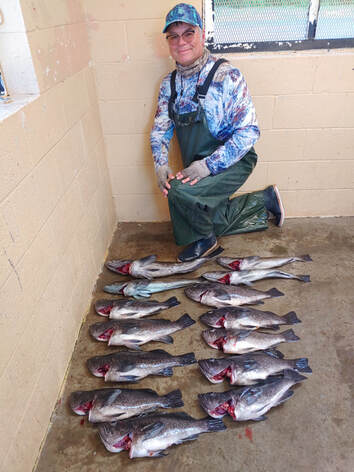 And in case you are wondering what that green fly rod is that I am holding in the top image, it is a custom built fiberglass 8 weight on a Gary Loomis Northfork blank built by George Krum. It rocks! Good fishing in your fly fish pursuits! Joe Western Native Trout Challenge West slope cutthroat from Eastern WA, one of Washington's native trout species. Earlier this year, a fly fishing partner introduced to a native trout quest called, Western Native Trout Challenge, westernnativetroutchallenge.org/. WNTC is a multi-state program hosted by the Western Native Trout Initiative. The ultimate goal is 21 native trout species from 12 states! There are three level of achievement, Expert Caster, Advanced Caster, and Master Caster. The Expert Caster can be repeated numerous times. If you have photos of western native trout you have caught before you sign up, the catch can still be applied to your application as long as it is after 1997. Fortunately, I had four species I could use and added two more to complete Expert Caster fairly quickly. The above image shows my catch of species and state. The cost is $25. Upon completion of the first stage, you earn a nice ball cap, the above certificate and a nice colored decal that says, "I love native trout" with a beautiful colored trout illustration. Being retired, this program gives me a very interesting opportunity to sort of collect these native trout species over a wide variety of landscapes and environments. Besides this program there are also quite a number of trout slams across the west from many state fish and game departments. California has a very impressive program called the Heritage Trout Challenge. 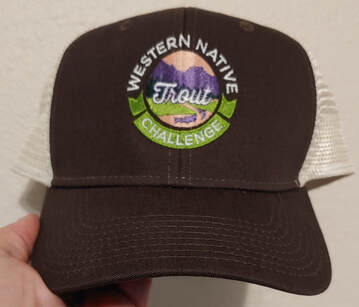 There are no time limits to complete the program. I believe these native trout challenges are a great way to impress upon outdoor seekers and anglers the importance of native trout conservation. For more information, there are some very exciting and interesting You Tube videos on the WNTC. Check it out! Best wishes on your native trout fly fish pursuit! Joe Trippin on the American Shad Here they come! As of yesterday, the total count is 2.3 million! The daily count for June 19th was 121,285 shad. Will the run reach 4 million, or 6 million or a new high of 7 million? Your guess is as good as mine but one thing is for certain, you can't beat the action with a fly rod! I took my 11 year old grandson out last Thurs and this is his favorite time of year. You know how kids are, if it's not happening, they get bored pretty fast, but with shad, that is definitely not the case! I'm in my usual place on the lower end of the shad rack below Bonneville Dam anchored in 6.5-8.5 feet. This is great time to use the fiberglass fly rods, 8 wts. The Airflo Depth finders in 300 and 400 grains work perfect. The 400 only goes out about 5 pulls on the color change and the 300 gets 10 pulls. The usual fly is my own, Sunshine Shad fly, tied with hot yellow glass beads! From the boat, it's just a matter of setting the lines behind the stern and wait for the grab or you can jig the line to entice strikes too. Swinging the fly towards the shore will catch fish, especially in the evening. Catching shad is a lot of fun and especially for people who are new to fly fishing, or new coming anglers and kids love it! The shad run is good at least till the end of June or when the run starts to taper off at about 75K per day. Otherwise, you can chase them up the Columbia and on to the Snake River below each dam!
Best wishes in your fly fish pursuit! Joe Rainbows of Rufus Woods I am especially blessed to have crossed the finish line and into RETIREMENT! My immediate plan was spending the first 10 days of it on Rufus Woods Reservoir on the Columbia River below Grand Coulee Dam. In short, it was epic! I easily caught well over 200 rainbow trout of mixed types; wild, typical diploid hatchery, and pig, triploids! I have been fly fishing here, on and off for over 28 years and it remains to be my most favorite water to fly fish in the Pacific Northwest. Rufus Woods offers exciting streamer and stillwater fly fishing! As usual, streamers were very effective in most places. I enjoy drifting out from the shoreline and using the bow mount electric motor to control the drift while casting towards shore and striping back to the boat. My preferred line is a 300 gr Airflo on a glass 8 wt. My fly choice is a weighted black bugger or an olive crayfish, sizes 4-2. Many times you can pull fish up from a 20-ft bottom, the trout are super aggressive! Nespelem bay held its usual swarm of hatchery rainbows, often grazing on the midge hatches. Literally hundreds of trout gather here to feed. The bay is the most popular spot on the reservoir for other fly fishers using float tubes, pontoon and small car topper boats as you can launch from the beach (so long as your vessel has no motor). Most fly anglers resort to bobber fishing using their favorite chironomid pattern. Red is a very effective color and a black balanced leech will draw strikes too. However, I prefer a clear intermediate sinking line with a #10 black beadhead bugger/leech or a balanced leech, which is deadly too. A florescent orange bead on a black body is my favorite. Four, five and six weights rods are common for this. The fly fishing experienced in Nespelem bay is also common on many parts of the reservoir, you just have to hunt for them and likely, you will be the only one fishing it. Nespelem bay is a "huge" back eddie. Back eddies gather significant midge hatches. It is not uncommon to see rising trout over 30-50 feet of water. The fish are in the top 8 feet of the water column. It's pretty impressive. Though the lunker rainbows (both non triploid and triploid) often move to different locations, it is no secret that the double digit triploids tend to keep close to the net pens to continue feeding on trout pellets that fall out. Three net pen groups are used by Pacific Aquaculture to rear the triploid rainbows, which, are actually all female steelhead. I was told years ago that the pens had a bottom or diaper to collect all the waste and non-eaten food (therefore the pellets couldn't escape). However, pellets still manage to fall out and as a result, many planted trout tend to congregate near the pens. It's not my favorite place to fly fish but you'd be surprised how many hold over planters, 10-20 lbs, are hanging out there waiting for free meals, lol. If you like eating fish, the triploid rainbows are excellent table fare. They are especially delicious when smoked! Just saying. Different species abound in the reservoir such as smallmouth bass, walleye, pike minnow, brown trout and brook trout. On this trip, I caught my second brook trout ever since fly fishing here in 1995. Simply put, not too many brookies around. I've also caught browns too and know of others that have been caught. I have not caught any monster browns (yet), mainly 15-20 inches but I do know of plus 24 inchers that have been caught. Hopefully the hatchery trout rule will protect these fish for a chance to grow BIG! The hatchery trout rule means that only trout with a clipped adipose fin may be kept. Incidentally while fly fishing for the trout you stand a good chance of catching a walleye, smallmouth bass or large pike minnow. I don't release these fish for reasons of preserving the trout populations. There are natural spawning rainbows in Rufus Woods and my hope is they become more prolific in the total trout population. The walleye and smallies are excellent table fare. Can't go wrong with fried breaded fillets. The pike minnow become eagle food. One of the recent changes in the angling regulations is that the limits on walleye and smallmouth have disappeared! Hopefully this is a good sign that the tribe and state are managing towards a much healthier trout population. Let's hope so! The best way to explore and fly fish Rufus Woods is in a motor boat. The upper fourth of the reservoir from Timm Brothers Farm to Grand Coulee Dam (only to the HWY 155 bridge in a boat) is the best water for a fly rod hands down. Make good use of maps because there are plenty of other places to launch small inflatable crafts. It may take a few times to become dialed in, but the dividends are well worth the time and effort!
Best wishes in your fly fish pursuit! Joe The smallmouth bass started out with a reasonable bite by the end of April with a few streaks of warm weather to so spur things on. The shores and side ponds of the Columbia River between Bonneville and McNary Dams started well and continue to produce great bass fishing. Most of all, popper fishing is in tall order and raising big bass is definitely probable. I noticed the weeds are choking some areas but no worries, look for the open pockets (even as small as a bathtub) and cast to it. Right now, intermediate sink and floating lines are the ticket as bass continue to feed near shore and are spawning. Fly choice is pretty simple, anything white or black does the trick. If your fly mimics a 2-4 inch bait fish or crayfish, it will produce too. I'm a big popper fan myself, so, I tend to fish on top most of the time. Killer popper time is the first 1 1/2 hrs of daylight and the end of daylight! I don't think popper color is a big deal, but I like, red/white, green/yellow, and black/yellow. the popper body is just about the size of an acorn or slightly larger. I prefer fly fishing from a boat but there are plenty of side sloughs and ponds along hwy 14 on the WA side and I-84 on the OR side. Float tubes provide a lot of versatility to get into tight places. Bass fishing should be good through most of the summer and the bite will become crazy again when the juvenile shad begin their out-migration.
Wishing the best in your fly fish pursuits, Joe |
































